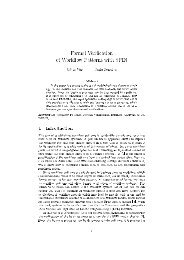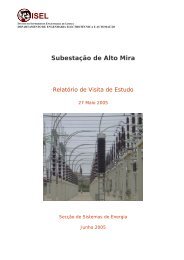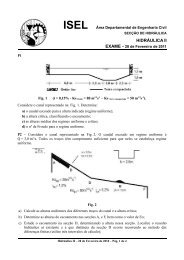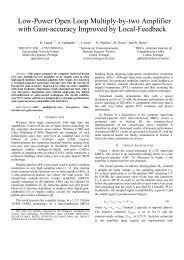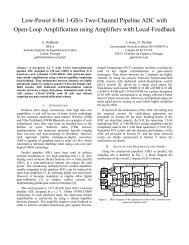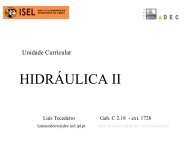Harmonics and Flicker Analysis in Arc Furnace Power Systems
Harmonics and Flicker Analysis in Arc Furnace Power Systems
Harmonics and Flicker Analysis in Arc Furnace Power Systems
Create successful ePaper yourself
Turn your PDF publications into a flip-book with our unique Google optimized e-Paper software.
It is clearly seen that the high harmonic distortion<br />
presented at the arc furnace (Bus 7) is greatly reduced by<br />
the transmission system.<br />
Us<strong>in</strong>g a program developed <strong>in</strong> MATLAB, based on a<br />
Fourier analysis of the time-doma<strong>in</strong> waveforms, the Total<br />
Harmonic Distortion (THD) is computed at the PCC <strong>and</strong><br />
<strong>Arc</strong> <strong>Furnace</strong> (Table 1 <strong>and</strong> Table 2). Results are presented<br />
<strong>in</strong> percentage of the 50 Hz component.<br />
timestep of 1.11 ms was used. The time-doma<strong>in</strong><br />
simulations are shown <strong>in</strong> Figure 7 <strong>and</strong> Figure 8.<br />
The program was used to predict the flicker severity<br />
associated with the voltage at PCC <strong>and</strong> at the <strong>Arc</strong> <strong>Furnace</strong>.<br />
The short-term flicker severity <strong>in</strong>dex (P st ) associated with<br />
the voltages shown, is presented <strong>in</strong> Table 3.<br />
Table 1. Voltage THD at the PCC <strong>and</strong> <strong>Arc</strong> <strong>Furnace</strong><br />
200<br />
150<br />
THD (%) - Voltage<br />
PCC (Bus 2) 0.25<br />
<strong>Arc</strong> <strong>Furnace</strong> (Bus 7) 32.53<br />
Table 2. Current THD at the PCC <strong>and</strong> arc furnace<br />
THD (%) – Current<br />
PCC (Bus 2) 2.08<br />
<strong>Arc</strong> <strong>Furnace</strong> (Bus 7) 13.26<br />
Voltage [kV]<br />
100<br />
50<br />
0<br />
-50<br />
-100<br />
-150<br />
-200<br />
0,0 0,1 0,2 0,3 0,4 0,5 0,6 0,7 0,8 0,9 1,0<br />
Time [s]<br />
Figure 7. Voltage waveform at the PCC (Bus 2)<br />
V. FLICKER<br />
1<br />
The flicker phenomenon is understood to refer to the<br />
sensation experienced by human vision when fast changes<br />
occur <strong>in</strong> the <strong>in</strong>tensity of light sources. A persistently<br />
vary<strong>in</strong>g illum<strong>in</strong>ation can cause significant annoyance <strong>and</strong>,<br />
<strong>in</strong> consequence, may lead to compla<strong>in</strong>ts of affected<br />
customers.<br />
Accord<strong>in</strong>g to extensive research work, it is known that<br />
flicker can be observed for repetitive voltage fluctuations<br />
up to a frequency where it is impossible for the eye to<br />
detect the fusion of images. This upper frequency limit can<br />
be placed approximately at 35 Hz for voltage changes less<br />
than 10 %.<br />
Moreover, the sensitivity of human visual perception<br />
has a frequency variation <strong>and</strong> exhibits a b<strong>and</strong>-pass<br />
response with maximum sensitivity between 8 <strong>and</strong> 10 Hz<br />
([10]).<br />
Bear<strong>in</strong>g <strong>in</strong> m<strong>in</strong>d that flicker mitigation techniques can<br />
be quite expensive, both for a customer with disturb<strong>in</strong>g<br />
load <strong>and</strong> for the electric utility, the International Union for<br />
Electroheat (UIE) has developed an <strong>in</strong>ternationally agreed<br />
<strong>in</strong>strument, called the flickermeter, to measure flicker <strong>and</strong><br />
established a criteria for the evaluation of flicker severity<br />
([9],[10]).<br />
In accordance to the procedure outl<strong>in</strong>ed <strong>in</strong> [9], a digital<br />
implementation of the UIE flickermeter was done us<strong>in</strong>g<br />
the MATLAB programm<strong>in</strong>g language. The<br />
implementation was validated us<strong>in</strong>g the normalised<br />
response to s<strong>in</strong>usoidal <strong>and</strong> rectangular voltage fluctuations<br />
for one unit of perceptibility presented <strong>in</strong> [10]. This<br />
program reads an <strong>in</strong>put voltage with a sample frequency of<br />
300 Hz. Therefore, when simulat<strong>in</strong>g the studied system, a<br />
Voltage [kV]<br />
0,8<br />
0,6<br />
0,4<br />
0,2<br />
0<br />
-0,2<br />
-0,4<br />
-0,6<br />
-0,8<br />
-1<br />
0,0 0,1 0,2 0,3 0,4 0,5 0,6 0,7 0,8 0,9 1,0<br />
Time [s]<br />
Figure 8. Voltage waveform at the <strong>Arc</strong> <strong>Furnace</strong> (Bus 7)<br />
Table 3. <strong>Flicker</strong> severity <strong>in</strong>dex at the PCC <strong>and</strong> <strong>Arc</strong><br />
<strong>Furnace</strong><br />
Pst<br />
PCC (Bus 2) 2.1<br />
<strong>Arc</strong> <strong>Furnace</strong> (Bus 7) 4.7<br />
VI. CONCLUSIONS<br />
The procedure presented <strong>in</strong> the paper allows for the<br />
accurate prediction of the harmonics <strong>and</strong> flicker generated<br />
by arc furnaces operation.<br />
A typical case is studied <strong>in</strong> order to show the different<br />
steps of the prediction. First, a three-phase ac electric arc<br />
model is implemented us<strong>in</strong>g the MODELS programm<strong>in</strong>g<br />
language.





